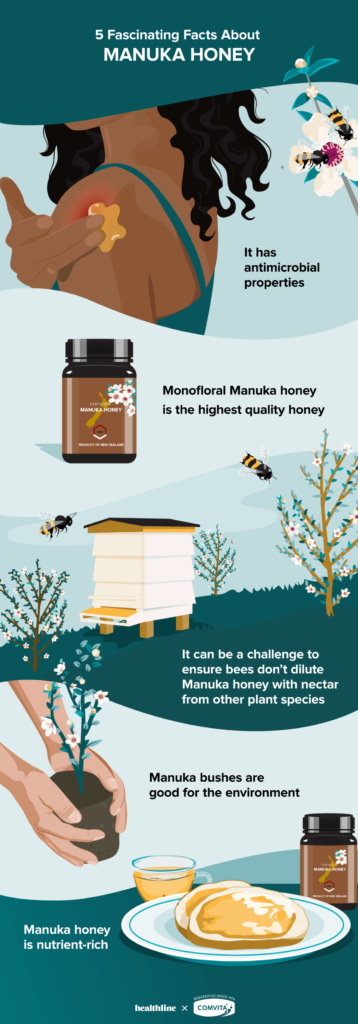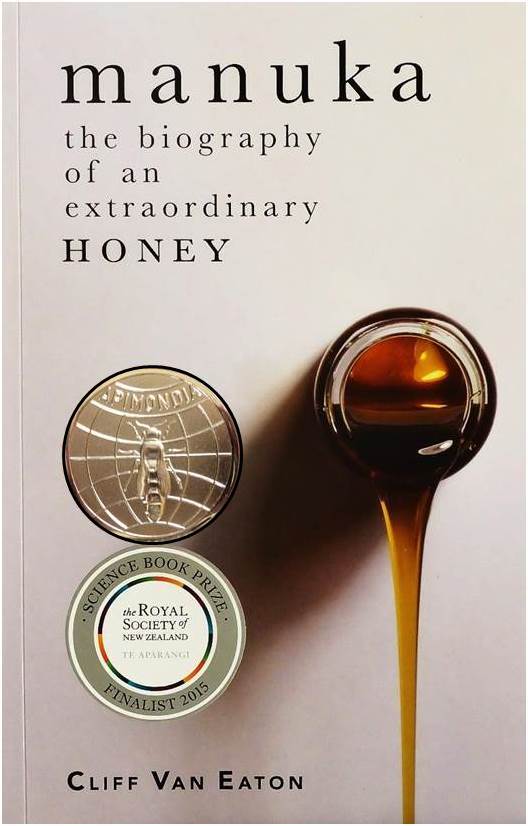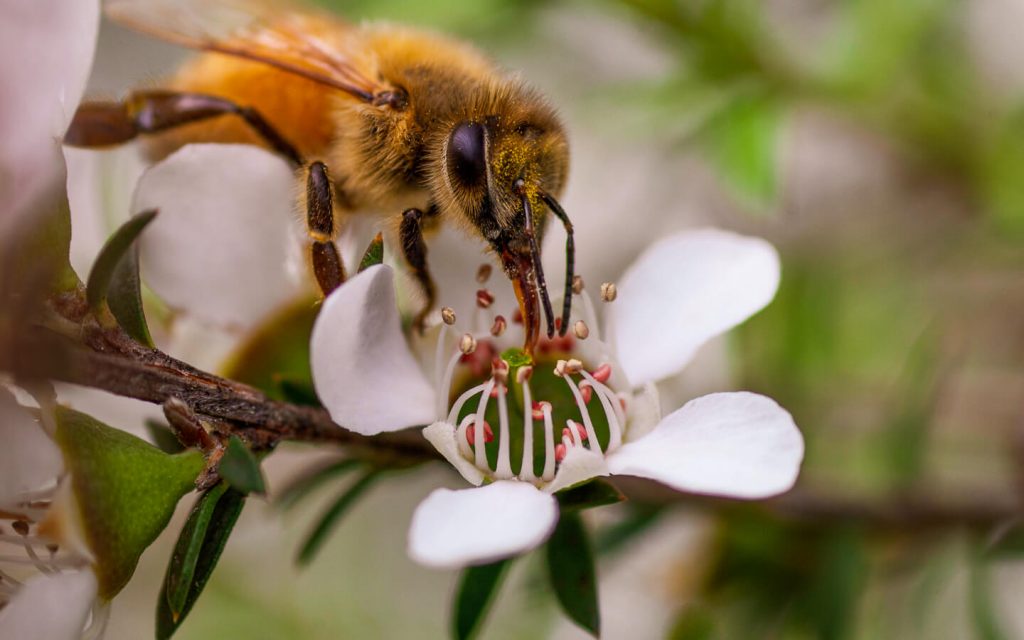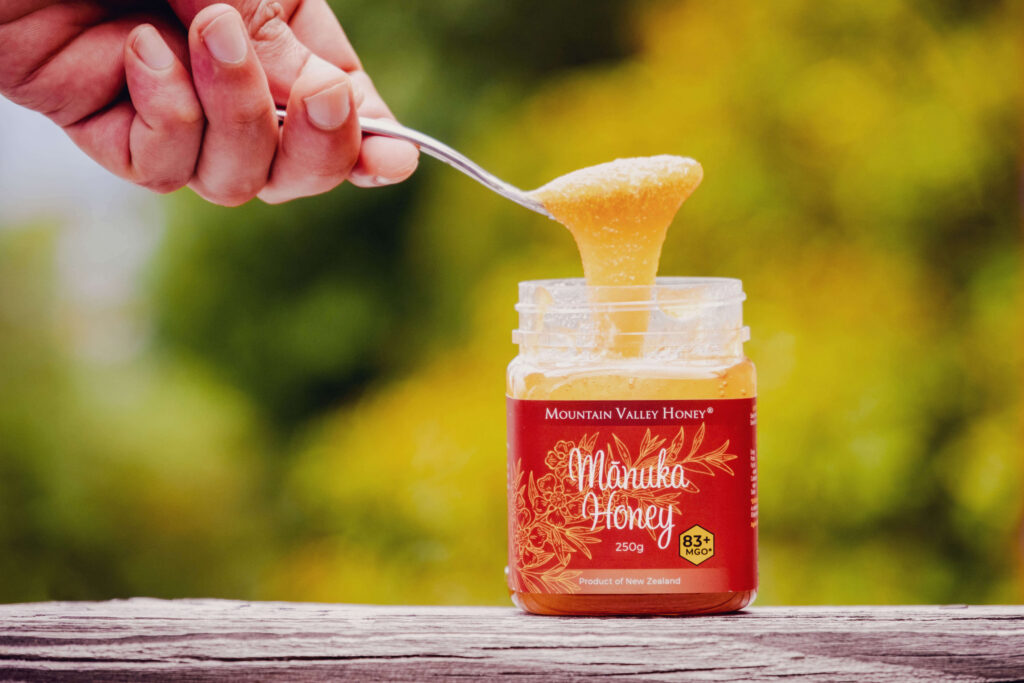
Imagine indulging in a spoonful of luscious golden honey that not only tantalizes your taste buds but also boasts extraordinary health benefits. Enter Manuka honey, the luxurious nectar renowned for its unique antibacterial properties and astonishingly high price tag. Have you ever wondered what makes this remarkable honey so expensive? Prepare to be intrigued as we uncover the fascinating science behind the captivating allure and steep price of Manuka honey.

The Unique Properties of Manuka Honey
Manuka honey is renowned for its unique properties that set it apart from other types of honey. These properties are a result of the Manuka tree and its nectar, as well as the honeybees and their pollination process, and the meticulous honey production process.
The Manuka Tree and its Nectar
The Manuka tree, scientifically known as Leptospermum scoparium, is native to New Zealand and Australia. It is the nectar from the flowers of this tree that gives Manuka honey its distinct characteristics. The Manuka tree is known for its ability to withstand harsh conditions, making it resilient and adaptable.
The nectar produced by the Manuka tree contains compounds that contribute to the unique properties of Manuka honey. One of these compounds is methylglyoxal (MGO), which is responsible for the honey’s potent antimicrobial effects. Another important compound is dihydroxyacetone (DHA), which undergoes a conversion process into MGO during the honey production process.
Honeybees and Pollination
Honeybees play a crucial role in the production of Manuka honey. They collect the nectar from the Manuka tree flowers and carry it back to their hives. During this process, enzymes present in the bees’ bodies interact with the nectar, transforming it into honey. The bees also add other beneficial substances, such as royal jelly and bee propolis, to the honey.
It is important to note that Manuka honey is primarily produced by European honeybees rather than the native Māori honeybee. This is because European honeybees are better suited to the commercial production of honey and can efficiently pollinate large Manuka plantations.
The Honey Production Process
Once the honeybees have collected the nectar, it is then brought back to the hive, where it undergoes a process of maturation and reduction of moisture content. This process involves bees evaporating excess moisture from the nectar, resulting in a thick, viscous substance we know as honey.
Manuka honey has a distinctive dark color and a rich, robust flavor. It is important to note that the quality of Manuka honey can vary depending on several factors, including the region where it is produced, the time of year, and the specific species of Manuka tree.
The Healing Benefits of Manuka Honey
Manuka honey is not only a delicious and versatile ingredient; it also offers a wide range of healing benefits. These benefits can be attributed to the honey’s antimicrobial properties, anti-inflammatory effects, wound healing properties, and its positive impact on digestive health.
Antimicrobial Properties
One of the most well-known properties of Manuka honey is its potent antimicrobial activity. The presence of MGO in Manuka honey gives it the ability to kill harmful bacteria, viruses, and fungi. This makes it an effective natural remedy for various infections, including skin conditions, sore throats, and digestive issues.
Numerous studies have demonstrated the effectiveness of Manuka honey in inhibiting the growth of bacteria such as Staphylococcus aureus and Helicobacter pylori. Its unique ability to fight antibiotic-resistant strains of bacteria, such as methicillin-resistant Staphylococcus aureus (MRSA), makes it a valuable asset in the medical field.
Anti-inflammatory Effects
In addition to its antimicrobial properties, Manuka honey also exhibits anti-inflammatory effects. It has been found to decrease inflammation in the body, which can help alleviate symptoms of inflammatory conditions such as arthritis and digestive disorders. The anti-inflammatory compounds in Manuka honey, such as flavonoids and phenolic acids, contribute to its therapeutic effects.
Wound Healing Properties
Manuka honey has long been used as a natural remedy for wound healing. Its antimicrobial and anti-inflammatory properties make it an effective treatment for burns, cuts, and ulcers. The honey’s ability to create a favorable wound healing environment is attributed to its low pH, high sugar content, and the presence of bioactive compounds.
Studies have shown that Manuka honey promotes tissue regeneration, reduces scarring, and accelerates the healing process. It creates a protective barrier on the skin, preventing infection and providing a moist environment that aids in the formation of new tissue.
Digestive Health Benefits
Manuka honey has also been found to have positive effects on digestive health. It can help soothe and heal the lining of the digestive tract, alleviating symptoms of conditions such as gastritis, acid reflux, and inflammatory bowel disease. Its antimicrobial properties target harmful bacteria in the gut, while its anti-inflammatory effects reduce inflammation in the digestive system.
Moreover, Manuka honey contains prebiotics, which serve as food for beneficial gut bacteria. This promotes a healthy balance of gut flora and supports overall digestive health.
The Manuka Honey Grading System
To ensure the authenticity and quality of Manuka honey, a grading system has been implemented. The two main rating systems used are the Unique Manuka Factor (UMF) and the MGO rating. These rating systems assess the concentration of MGO in the honey, which is a key indicator of its potency and therapeutic value.
UMF and MGO Ratings
UMF is a trademarked rating system that measures the levels of MGO, leptosperin, and dihydroxyacetone (DHA) found in Manuka honey. The higher the UMF rating, the higher the concentration of these compounds, and therefore, the greater the honey’s therapeutic potential.
MGO rating, on the other hand, focuses solely on the concentration of MGO in the honey. It is a simpler and more direct grading system, with higher MGO ratings indicating a higher level of antimicrobial activity.
Consumers can use these rating systems to determine the quality and authenticity of Manuka honey before making a purchase.
Testing for Authenticity
Due to the high demand and premium price of Manuka honey, there have been cases of counterfeit products flooding the market. To combat this issue, various testing methods have been developed to authenticate Manuka honey.
One of the most commonly used tests is the presence of leptosperin, a naturally occurring compound found in Manuka honey. Testing for leptosperin, along with other markers such as MGO and DHA, helps ensure that the honey is genuine and meets the required standards.
Quality Control Measures
To maintain the quality of Manuka honey, strict quality control measures are implemented throughout the production process. This includes monitoring the beekeeping practices, ensuring the bees are foraging in areas with sufficient Manuka trees, and maintaining high hygiene standards during honey extraction and packaging.
Additionally, reputable honey producers often voluntarily submit their products for third-party testing and certification. This provides consumers with reassurance regarding the quality and authenticity of the Manuka honey they purchase.
The Limited Supply of Manuka Honey
Despite its growing popularity, the supply of Manuka honey remains limited. Several factors contribute to this limited availability, including the rarity of Manuka trees, environmental factors, and competition for resources.
The Rarity of Manuka Trees
Manuka trees have specific growth requirements and are only found in certain regions of New Zealand and Australia. This limited geographical distribution makes it challenging to cultivate large-scale Manuka plantations.
Furthermore, the Manuka tree has a relatively slow growth rate and does not produce nectar continuously throughout the year. It predominantly flowers during the summer months and produces limited quantities of nectar, further restricting the supply of Manuka honey.
Environmental Factors
The growth and health of Manuka trees are influenced by various environmental factors. Factors such as soil type, climate conditions, and access to water play a crucial role in determining the quality and quantity of nectar produced.
Droughts, floods, and other natural disasters can have a significant impact on the growth and survival of Manuka trees. These environmental challenges contribute to the fluctuations in Manuka honey production and can result in reduced availability during certain years.
Competition for Resources
Manuka trees provide valuable resources to various organisms, including honeybees, other pollinators, and wildlife. The competition for these resources further limits the supply of Manuka honey.
Other bee species, native insects, and birds also rely on the nectar and pollen from Manuka trees for their survival. Balancing the needs of these different organisms while ensuring a sustainable supply of Manuka honey requires careful management and conservation efforts.

The Costly Beekeeping Practices
The production of Manuka honey involves specialized beekeeping techniques, labor-intensive harvesting and extraction processes, as well as protective measures for bees. These factors contribute to the higher costs associated with Manuka honey production.
Specialized Beekeeping Techniques
Manuka honey production requires beekeepers with specialized knowledge and skills. They need to understand the specific needs of honeybees when foraging on Manuka trees and ensure the bees remain healthy and productive.
Beekeepers place their hives strategically near Manuka tree sites to maximize honey production. They monitor the hives regularly, conduct inspections, and provide supplemental feeding when necessary.
Labor-Intensive Harvesting and Extraction
The harvesting and extraction of Manuka honey is a labor-intensive process. Beekeepers carefully collect the honeycombs from the hives, making sure not to disturb the bees or damage the comb.
Once the honeycombs are collected, the honey extraction process begins. It involves carefully removing the honey from the comb and filtering it to remove any impurities or debris. This process, although time-consuming, ensures a high-quality final product.
Protective Measures for Bees
Beekeepers take various measures to protect their bees and ensure their well-being during the honey production process. This includes safeguarding the hives against pests and diseases, providing appropriate nutrition, and maintaining a clean and hygienic living environment for the bees.
Moreover, as Manuka honey production relies heavily on European honeybees, measures are taken to prevent the spread of diseases and pests that could harm the bees’ health and the overall industry.
The Impact of Manuka Honey Fraud
The high value and demand for Manuka honey have unfortunately led to cases of fraud within the industry. Counterfeit products and misleading labeling practices pose significant challenges to both consumers and legitimate producers.
Counterfeit Products
Counterfeit Manuka honey refers to honey that is falsely labeled or adulterated to imitate the genuine product. This can include diluting or blending Manuka honey with cheaper types of honey or even using artificial additives to mimic its distinctive characteristics.
The production and sale of counterfeit Manuka honey not only deceive consumers but also undermine the credibility of authentic producers. It is essential for consumers to be vigilant and purchase Manuka honey from reputable sources to avoid falling victim to fraud.
Misleading Labeling
Misleading labeling practices can also contribute to the problem of Manuka honey fraud. Some products may claim to be Manuka honey or use terms such as “Manuka-like” without meeting the necessary quality standards. This can confuse consumers and make it difficult to distinguish genuine Manuka honey from imitations.
Regulatory bodies and industry associations are working to address this issue by establishing stricter regulations and promoting transparency in labeling practices. Education and awareness among consumers are also vital in combating misleading labeling.
Consumer Awareness
To protect themselves from fraudulent practices, consumers should be aware of the key indicators of genuine Manuka honey. Checking for UMF or MGO ratings, as well as looking for third-party testing and certification, can provide assurance of authenticity.
Additionally, it is important for consumers to do their research, read reviews, and purchase from reputable retailers or directly from trusted honey producers. By staying informed and making informed choices, consumers can support the industry and discourage fraudulent practices.

The Demand and Marketing of Manuka Honey
Manuka honey has seen a surge in popularity in recent years, driven by the increasing interest in natural remedies and the promotion of its unique healing properties. This growing demand has led to extensive marketing efforts and higher retail and advertising costs.
Increasing Popularity of Natural Remedies
As people become more conscious of their health and well-being, there has been a shift towards natural remedies and holistic approaches to healthcare. Manuka honey’s healing benefits align with this trend, making it a sought-after product in the market.
Consumers are increasingly seeking natural alternatives for skincare, wound care, and digestive health. The growing popularity of Manuka honey as a natural remedy has contributed to its increased demand and higher prices.
Promotion of Manuka Honey
To capitalize on the demand for Manuka honey, various marketing strategies have been employed to promote its unique properties and benefits. This includes targeted advertising campaigns, endorsements from celebrities and influencers, and educational content highlighting the honey’s healing potential.
The marketing efforts often focus on the honey’s antimicrobial, anti-inflammatory, and wound healing properties. The use of testimonials and scientific research further enhances the credibility and appeal of Manuka honey as a premium product.
Higher Retail and Advertising Costs
The demand for Manuka honey and the need for extensive marketing have resulted in higher retail and advertising costs. Retailers often stock Manuka honey as a premium product, commanding higher prices compared to other types of honey.
Advertising campaigns, product packaging, and promotional materials also incur additional expenses, all of which are reflected in the final price paid by consumers. The high production costs, combined with marketing expenditures, contribute to the overall high price of Manuka honey.
The Role of Manuka Honey in the Economy
Manuka honey plays a significant role in the economy, particularly in New Zealand, where it is most commonly produced. The industry provides export opportunities, economic benefits for beekeepers and honey producers, and contributes to the country’s tourism sector.
Export Opportunities for New Zealand
New Zealand is the primary exporter of Manuka honey, capitalizing on the country’s unique geographic conditions and abundance of Manuka trees. The export of Manuka honey creates valuable economic opportunities, contributing to the country’s foreign exchange earnings.
The high demand for Manuka honey from international markets, particularly in Asia and Europe, has opened doors for New Zealand producers to establish trade relationships and expand their businesses. This boosts the economy and strengthens the country’s position as a leading honey exporter.
Economic Benefits for Beekeepers and Honey Producers
The production of Manuka honey provides economic benefits for beekeepers and honey producers. The premium price of Manuka honey allows them to command higher profits compared to other types of honey.
This financial incentive attracts beekeepers to specialize in Manuka honey production, driving growth in the industry. It also encourages investment in research and development to improve production methods and quality control, further enhancing the economic viability of Manuka honey production.
Contribution to Tourism
Manuka honey’s association with New Zealand’s unique flora and fauna has made it a sought-after souvenir for tourists visiting the country. Many tourists are drawn to the opportunity to purchase authentic and high-quality Manuka honey, supporting local businesses and the tourism sector.
Honey tours and beekeeping experiences have become popular among tourists, providing insights into the fascinating world of bees and honey production. The presence of Manuka honey in the tourism landscape adds value to the overall visitor experience and contributes to the local economy.

The Ethical and Sustainable Practices
Manuka honey production is not only focused on economic gain but also on ethical and sustainable practices. These practices include supporting local communities, environmental conservation, and protecting bee populations.
Supporting Local Communities
Manuka honey production supports local communities, particularly in rural areas where beekeeping is prevalent. It provides employment opportunities for beekeepers, harvesters, and workers involved in honey extraction and processing.
Moreover, beekeeping contributes to the overall agricultural diversity of the region, providing economic stability and enhancing the resilience of rural communities. The industry’s commitment to fair trade practices and partnerships with local communities further strengthens the socio-economic impact of Manuka honey production.
Environmental Conservation
Manuka honey production takes into account the importance of environmental conservation. Beekeepers and honey producers recognize the vital role of Manuka trees in maintaining biodiversity and the overall health of the ecosystem.
Efforts are made to protect and enhance the natural habitat of Manuka trees, ensuring sustainable foraging areas for honeybees. These practices include responsible land management, reforestation initiatives, and the preservation of native vegetation.
Protecting Bee Populations
In recent years, there has been a growing concern about the decline in global bee populations. Manuka honey producers are committed to the well-being and protection of honeybees, recognizing their vital role as pollinators and the sustainability of their industry.
Beekeepers implement best management practices to support hive health and minimize the use of chemicals that may harm bee populations. They also contribute to bee conservation efforts through research, education, and collaboration with organizations dedicated to bee welfare.
The Future of Manuka Honey’s Pricing
The pricing of Manuka honey is influenced by various factors, including technological advancements, sustainable farming techniques, and evolving consumer trends. These factors will continue to shape the future of Manuka honey and its affordability.
Technological Advancements
Advancements in technology are likely to have a significant impact on Manuka honey production and pricing. This includes improvements in hive monitoring systems, precision beekeeping techniques, and honey extraction processes.
Technological innovations can increase efficiency, reduce production costs, and improve quality control measures. This, in turn, may contribute to more affordable pricing for Manuka honey while maintaining its high standards and unique properties.
Sustainable Farming Techniques
As consumers become increasingly conscious of sustainability, there is a growing demand for products produced using sustainable practices. This includes environmentally friendly farming techniques, responsible land management, and ethical beekeeping practices.
The adoption of sustainable farming techniques in Manuka honey production can lead to cost savings and increased efficiency. Furthermore, it aligns with consumer preferences and expectations, creating a positive impact on the industry’s reputation and pricing.
Consumer Trends
Consumer trends and preferences can influence the pricing of Manuka honey as well. As the demand for natural remedies and functional foods continues to rise, the popularity of Manuka honey may increase further.
However, evolving market dynamics and shifts in consumer behavior can also impact pricing. Factors such as the emergence of alternative natural remedies, changes in consumer disposable income, and shifts in purchasing behaviors may influence the supply and demand dynamics of Manuka honey.
Ultimately, the future pricing of Manuka honey will depend on a delicate balance between meeting consumer demand, maintaining quality standards, and ensuring the sustainability of the industry.
